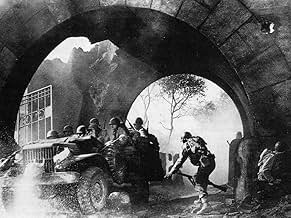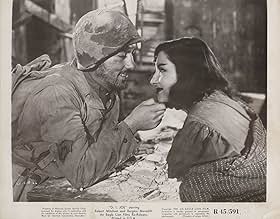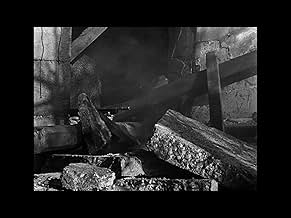VALUTAZIONE IMDb
7,2/10
4056
LA TUA VALUTAZIONE
Aggiungi una trama nella tua linguaAt the close of WWII, Pulitzer Prize-winning war correspondent Ernie Pyle travels with, and reports on, the U.S. Army's 77th Infantry Division during their liberation of Italy.At the close of WWII, Pulitzer Prize-winning war correspondent Ernie Pyle travels with, and reports on, the U.S. Army's 77th Infantry Division during their liberation of Italy.At the close of WWII, Pulitzer Prize-winning war correspondent Ernie Pyle travels with, and reports on, the U.S. Army's 77th Infantry Division during their liberation of Italy.
- Regia
- Sceneggiatura
- Star
- Candidato a 4 Oscar
- 5 vittorie e 8 candidature totali
John R. Reilly
- Private Murphy
- (as Jack Reilly)
William Murphy
- Private Mew
- (as Bill Murphy)
William 'Billy' Benedict
- Pvt. Whitey
- (non citato nei titoli originali)
Michael Browne
- Sergeant
- (non citato nei titoli originali)
Dorothy Coonan Wellman
- Nurse Lt. Elizabeth 'Red' Murphy
- (non citato nei titoli originali)
Bob Hope
- Bob Hope (Voice on Radio Program)
- (voce)
- (non citato nei titoli originali)
Kenneth Kendall
- Extra
- (non citato nei titoli originali)
Yolanda Lacca
- Amelia, Italian Girl
- (non citato nei titoli originali)
Barney Noto
- Staff Sergeant Barney Noto
- (non citato nei titoli originali)
Tito Renaldo
- Lopez
- (non citato nei titoli originali)
Dick Rich
- Sergeant at Showers
- (non citato nei titoli originali)
William Self
- Pvt. Cookie Henderson
- (non citato nei titoli originali)
Recensioni in evidenza
And war was fought in the rain and the mud and the cold....In today's wars fought on film there is very rarely a look at the true living conditions that existed. This movie does not clean up the actors (as most films do). You see here all of the gritty, day-to-day, living during the war. These guys did not clean up every day. This is a good story about WW2. Be sure to see it. 8/10
The term "G.I. Joe" has become so closely associated with the image of a certain toy that it is now largely forgotten that it was originally coined to describe the ordinary American foot soldier. Likewise, it is now largely forgotten just exactly who Ernie Pyle was and what he meant to the American people and, more especially, to the ordinary soldiers about whom he wrote.
My father took a photograph of Ernie Pyle in the Pacific in 1945, shortly before Pyle was killed. At the time Pyle was surrounded by a mob of admiring G.Is. You'd have thought they were in the presence of Bettie Grable or Rita Hayworth rather than a short, balding, middle aged newspaper-man. When Pyle was killed in action a few days later while accompanying the infantry, the solders erected a monument at the place where he died. On it were engraved the words, "On this spot the 77th Division lost a buddy", and they really meant it. It's inconceivable that troops today would do anything like that for one of the current crop of CNN-generation reporters.
The reason isn't hard to fathom. Most war correspondents hung around the rear echelon, hobnobbing with the general staff and forwarding dispatches from headquarters, and they still do. Pyle, on the other hand, lived with and wrote about the common infantrymen who were actually fighting the war. He ate their food, drank their coffee and shared their hardships through three grueling years of war from North Africa through Sicily to the European mainland, and then later on in the Pacific, where he was killed. Pyle became the spokesman for the common soldiers, and all their families back home read his syndicated column. There simply wasn't anybody else like him then, and there hasn't been since.
Small wonder that William Wellman, himself a combat veteran, thought that this movie needed to be made. The filmmaker had tremendous respect for his subject, and it shows. For example, that poignant last scene is, almost word for word and image for image, straight out of one of Pyle's most famous dispatches. It would have been interesting to learn what Pyle thought of this film. Unfortunately, however, by the time it was released the Pulitzer Prize-winning reporter was already dead.
My father took a photograph of Ernie Pyle in the Pacific in 1945, shortly before Pyle was killed. At the time Pyle was surrounded by a mob of admiring G.Is. You'd have thought they were in the presence of Bettie Grable or Rita Hayworth rather than a short, balding, middle aged newspaper-man. When Pyle was killed in action a few days later while accompanying the infantry, the solders erected a monument at the place where he died. On it were engraved the words, "On this spot the 77th Division lost a buddy", and they really meant it. It's inconceivable that troops today would do anything like that for one of the current crop of CNN-generation reporters.
The reason isn't hard to fathom. Most war correspondents hung around the rear echelon, hobnobbing with the general staff and forwarding dispatches from headquarters, and they still do. Pyle, on the other hand, lived with and wrote about the common infantrymen who were actually fighting the war. He ate their food, drank their coffee and shared their hardships through three grueling years of war from North Africa through Sicily to the European mainland, and then later on in the Pacific, where he was killed. Pyle became the spokesman for the common soldiers, and all their families back home read his syndicated column. There simply wasn't anybody else like him then, and there hasn't been since.
Small wonder that William Wellman, himself a combat veteran, thought that this movie needed to be made. The filmmaker had tremendous respect for his subject, and it shows. For example, that poignant last scene is, almost word for word and image for image, straight out of one of Pyle's most famous dispatches. It would have been interesting to learn what Pyle thought of this film. Unfortunately, however, by the time it was released the Pulitzer Prize-winning reporter was already dead.
War Correspondent Ernie Pyle (Burgess Meredith) joins an Infantry company led by Lt. Walker (Robert Mitchum) in North Africa. The men are surprised when Ernie decides to accompany them all the way to the front. After Kasserine Pass, they find themselves in Italy. They fight up the boot and is halted in front of Monte Cassino.
It is a relatively realistic portrait of war considering the times. Ernie Pyle is a real Pulitzer Prize-winning war correspondent killed in Okinawa two months before the movie's release. It uses many of his writing which contributes to the realism. He really paints a picture with his words. It doesn't always get the visceral grim reality with the interior studio sets. It always looks better outdoors. They create a great location which does look like a bombed out Italian town. Monte Cassino is mostly interior shoot as the fighters go underground. The monastery is no longer standing anyways but there is footage of the bombing. This is as real as it gets for its time.
It is a relatively realistic portrait of war considering the times. Ernie Pyle is a real Pulitzer Prize-winning war correspondent killed in Okinawa two months before the movie's release. It uses many of his writing which contributes to the realism. He really paints a picture with his words. It doesn't always get the visceral grim reality with the interior studio sets. It always looks better outdoors. They create a great location which does look like a bombed out Italian town. Monte Cassino is mostly interior shoot as the fighters go underground. The monastery is no longer standing anyways but there is footage of the bombing. This is as real as it gets for its time.
It's odd that a director noted for his aviation films would choose to direct a film about the infantry, but William Wellman knew a great subject when he saw it. Remember he also did the deservedly highly acclaimed Battleground.
Independent producer Lucas Cowen got together with Ernie Pyle and approached Wellman. They left copies of the stories Pyle wrote from the front in Africa and Italy and Wellman read them in a night's sitting and agreed to do the film.
The Story of GI Joe is based on the various stories and characters that World War II's most famous correspondent encountered. In fact aside from Robert Mitchum and a couple of other actors, the men in this film are real GIs who were in transit from the European to the Pacific Theater and a lot were killed after they arrived in the Pacific as did the real Ernie Pyle who never got to see the finished product.
Burgess Meredith does a fine job recreating the modest chronicler that was Ernie Pyle. In civilian life aside from news stories, Pyle was famous for his cross country travels and stories he wrote about people from all walks of life. Very much like the late television commentator Charles Kuralt did on CBS morning news on Sundays.
When war broke out Pyle did not cover the war of the generals, he spent his time with the troops and told their story. For that he was respected and beloved as now other war correspondent has ever been before or since. In this film Pyle is introduced to the men of one company which transports him to that first American battle and defeat at Kasserine Pass in north Africa. And he runs into them again and again through Sicily right to the liberation of Rome.
Robert Mitchum plays the lieutenant later captain in charge of this company. He'd broken into films with some Hopalong Cassidy pictures and did bits in other films. In fact when its cowboy star Tim Holt enlisted in the armed forces, RKO pictures had signed Mitchum to be his replacement and he'd done two films Nevada and West of the Pecos when he read for the part of Lieutenant Walker.
If it weren't for this film, Robert Mitchum might have continued to be a B picture cowboy star. For his portrayal of the stern, but compassionate officer in whom Pyle finds a kindred spirit, Robert Mitchum got his only Academy Award nomination for Best Supporting Actor. He lost that year to James Dunn for A Tree Grows in Brooklyn. He never received another nomination, but he certainly became a legend although he'd have been the first to debunk that title.
Lots of newsreel footage from the Mediterranean theater make The Story of GI Joe one of the most realistic war films ever done. That's remarkable too, considering most of the Hollywood product back then was propaganda hype, good and bad. It has remained a classic to this day and a wonderful tribute to that chronicler of the infantry, Ernie Pyle.
Independent producer Lucas Cowen got together with Ernie Pyle and approached Wellman. They left copies of the stories Pyle wrote from the front in Africa and Italy and Wellman read them in a night's sitting and agreed to do the film.
The Story of GI Joe is based on the various stories and characters that World War II's most famous correspondent encountered. In fact aside from Robert Mitchum and a couple of other actors, the men in this film are real GIs who were in transit from the European to the Pacific Theater and a lot were killed after they arrived in the Pacific as did the real Ernie Pyle who never got to see the finished product.
Burgess Meredith does a fine job recreating the modest chronicler that was Ernie Pyle. In civilian life aside from news stories, Pyle was famous for his cross country travels and stories he wrote about people from all walks of life. Very much like the late television commentator Charles Kuralt did on CBS morning news on Sundays.
When war broke out Pyle did not cover the war of the generals, he spent his time with the troops and told their story. For that he was respected and beloved as now other war correspondent has ever been before or since. In this film Pyle is introduced to the men of one company which transports him to that first American battle and defeat at Kasserine Pass in north Africa. And he runs into them again and again through Sicily right to the liberation of Rome.
Robert Mitchum plays the lieutenant later captain in charge of this company. He'd broken into films with some Hopalong Cassidy pictures and did bits in other films. In fact when its cowboy star Tim Holt enlisted in the armed forces, RKO pictures had signed Mitchum to be his replacement and he'd done two films Nevada and West of the Pecos when he read for the part of Lieutenant Walker.
If it weren't for this film, Robert Mitchum might have continued to be a B picture cowboy star. For his portrayal of the stern, but compassionate officer in whom Pyle finds a kindred spirit, Robert Mitchum got his only Academy Award nomination for Best Supporting Actor. He lost that year to James Dunn for A Tree Grows in Brooklyn. He never received another nomination, but he certainly became a legend although he'd have been the first to debunk that title.
Lots of newsreel footage from the Mediterranean theater make The Story of GI Joe one of the most realistic war films ever done. That's remarkable too, considering most of the Hollywood product back then was propaganda hype, good and bad. It has remained a classic to this day and a wonderful tribute to that chronicler of the infantry, Ernie Pyle.
I entered for 17 weeks of infantry basic training at Camp Roberts California in January,1945. I was just 18. I was in the 96th, inf, training battlion. I am 73 now. The movie about Ernie Pyle was being made there in part. Some of the trainees were in the film. I recall my company marching over and over on this same hill to make it look like there was a full army there for the picture. My company commander was in the film as was the company mascot dog. I can't recall much more about the film as I have'nt seen it in a long time, getting old I guess. I surely would like to have a VCR copy of it too. If anyone has a copy to sell, please let me know. I recall that Burgess Meredith had lunch in the mess hall and shot the bull with the G.I.s there. Thats about all that I can remember for now. Hope this helps. G
Lo sapevi?
- QuizThe extras in the film were real American GIs, in the process of being transferred from the war in Europe to the Pacific. Many of them were killed in the fighting on Okinawa--the same battle in which Ernie Pyle was killed by a Japanese machine gunner--never having seen the movie in which they appeared.
- BlooperThe unit Pyle is with--the 18th Infantry Regiment, 1st Infantry Division--never fought in the Italian campaign. After the Sicilian campaign ended, it was brought back to England and began training for the D-Day invasion in Normandy. The 1st Division would eventually spearhead the assault on Omaha Beach.
- Citazioni
Pvt. Dondaro: If this War don't kill me first, my feet will.
- Curiosità sui creditiThere are absolutely no credits at the end of the film, not even the words "The End".
- ConnessioniEdited from San Pietro (1945)
- Colonne sonoreSilent Night
(uncredited)
Music by Franz Xaver Gruber
Lyrics by Joseph Mohr
Sung by Elfie Mayerhofer on Decca Record
I più visti
Accedi per valutare e creare un elenco di titoli salvati per ottenere consigli personalizzati
- How long is Story of G.I. Joe?Powered by Alexa
Dettagli
- Data di uscita
- Paese di origine
- Lingue
- Celebre anche come
- También somos seres humanos
- Luoghi delle riprese
- Iverson Ranch - 1 Iverson Lane, Chatsworth, Los Angeles, California, Stati Uniti(marching through countryside just before the "baptism of fire.")
- Azienda produttrice
- Vedi altri crediti dell’azienda su IMDbPro
Botteghino
- Budget
- 1.000.000 USD (previsto)
- Tempo di esecuzione1 ora 48 minuti
- Colore
- Proporzioni
- 1.37 : 1
Contribuisci a questa pagina
Suggerisci una modifica o aggiungi i contenuti mancanti

Divario superiore
By what name was I forzati della gloria (1945) officially released in India in English?
Rispondi






























